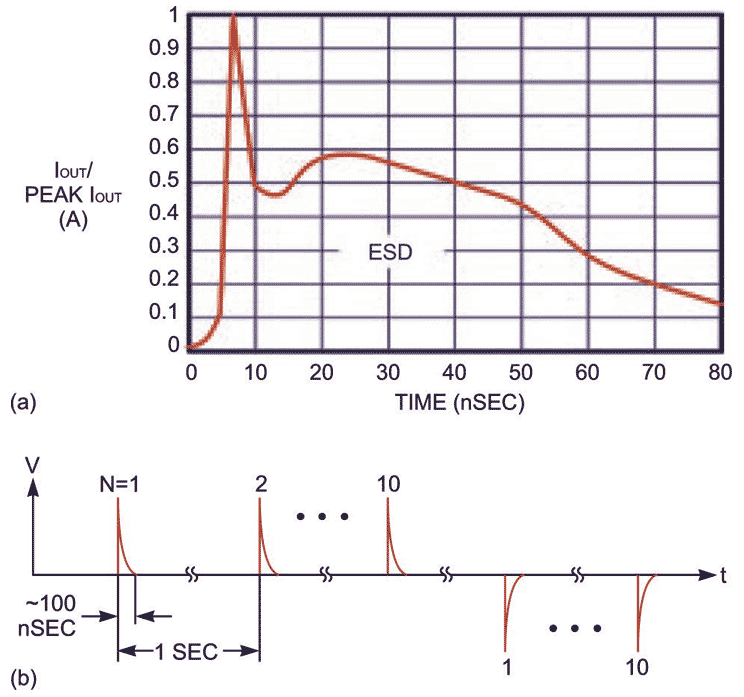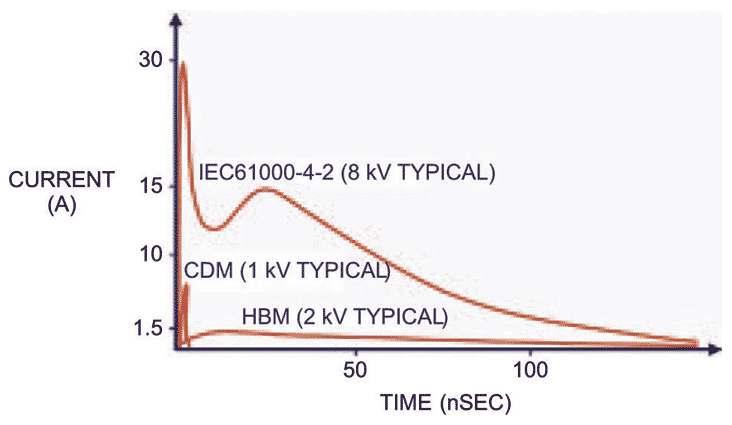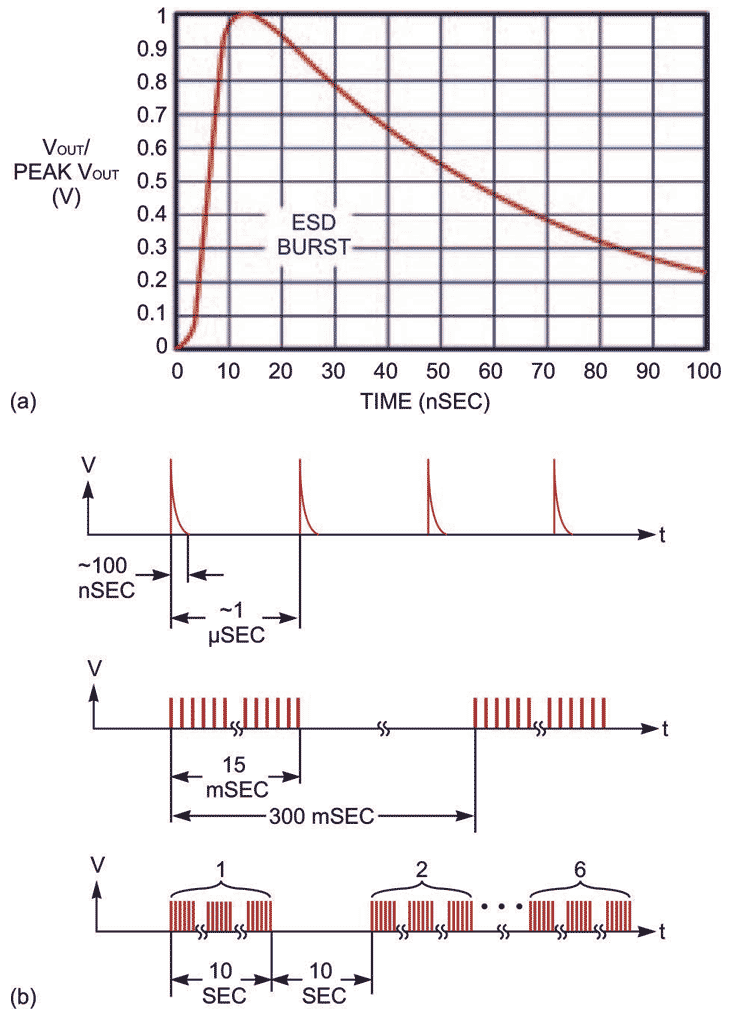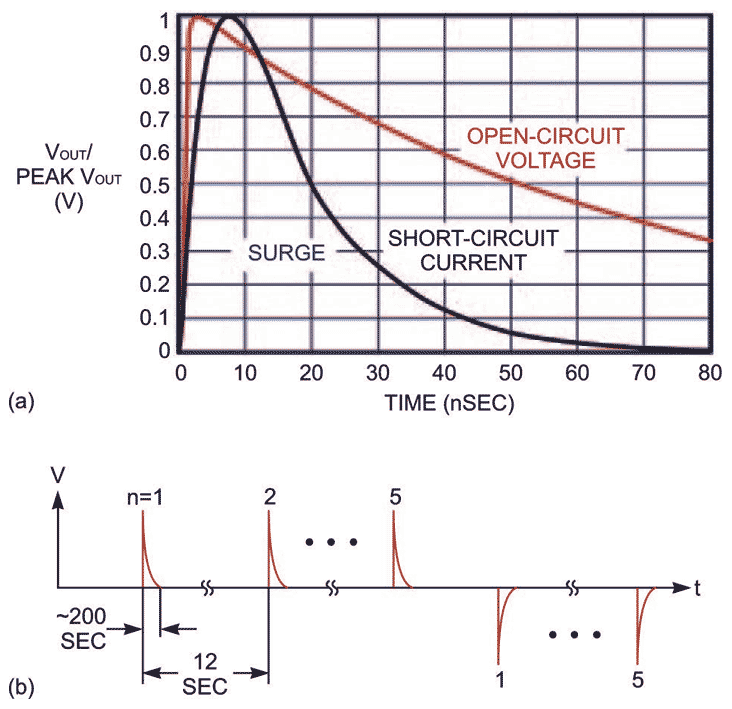ESD immunity
The system-level ESD-immunity test simulates the ESD of a human onto an electronic component (Figure 7a). Electrostatic charge on a human can develop in low relative humidity, on low-conductivity carpets, and on vinyl garments. To simulate a discharge event, an ESD generator applies ESD pulses to the EUT (equipment under test) in two ways. The first is through contact discharge, or direct contact with the EUT, in which something makes physical contact with the EUT. The second is through air-gap discharge, or indirect contact with the EUT, in which the discharge occurs through the air. The IEC (International Electrotechnical Commission) defines this test in the IEC61000-4-2 ESD-immunity-test specification.
 |
|
| Figure 7. | The system-level ESD-immunity test simulates the ESD of a human onto an electronic component (a). You test the EUT at least 20 times for the ESD-immunity system-level specification (b). |
Characteristics for this test are a rise time of less than 10 nsec and a pulse width of approximately 100 nsec, indicating a low-energy, static pulse. The ESD-immunity test requires that you administer at least 10 discharges of both positive and negative polarity at 1-sec intervals. Thus, you test the EUT at least 20 times for the ESD-immunity system-level specification (Figure 7b).
Figure 8 shows the differences between device- and system-level testing standards. The IEC ESD test, which many consider the gold standard for component testing, typically has an eight-times-higher testing voltage than CDM and 20-times-higher peak-current testing than HBM.
 |
|
| Figure 8. | The IEC ESD test typically has an eight-times-higher testing voltage than CDM and a 20-times-higher testing peak current than HBM. |
EFT immunity
The system-level-testing standard of IEC61000-4-4 is the EFT (electrical-fast-transient) immunity-testing model (Figure 9a). The EFT-, or burst-, immunity test simulates transients that can happen in everyday environments due to switching off inductive loads, relay-contact bounce, and the operation of dc or universal motors. This test is performed on all power, signal, and earth wires. A burst is the sequence of pulses with a finite duration. In the EFT-immunity test, a burst generator produces a sequence of test pulses that attenuate to 50% of their peak values in less than 100 nsec. The next adjacent pulse typically occurs 1 μsec later. A burst typically lasts for 15 msec, and the burst period, the time from one burst’s start to the next burst’s start, is 300 msec. This cycle repeats for 10 sec, after which there is no testing for 10 seconds. This scenario represents one test cycle. The test cycle must repeat six times, taking 110 sec. The significance of the EFT-immunity test is its short pulse rise times, high repetition rates, and low energy content.
 |
|
| Figure 9. | The system-level-testing standard of IEC61000-4-4 is the EFT-immunity-testing model (a). Industrial-grade cabling with internal shielding can produce great results to the DUT by drastically attenuating the coupling of EFT energy into the conductors (b). |
Although the fast rise time and the low energy content of an EFT are somewhat similar to those of an ESD pulse, the number of pulses per test cycle is not. Assuming a 1-μsec interval between one pulse front and the next, a 15-msec EFT burst contains at least 15,000 pulses. Multiplying the number of bursts within a 10-sec window yields 10 sec/300 msec=33.3 bursts and 500,000 pulses per 10-sec window. Thus, the application of six 10-sec windows with a 10-sec pause interval results in 3 million pulses within 110 sec.
Surge immunity
The surge-immunity, or lightning, test, IEC61000-4-5, represents the most severe transient-immunity test in current and duration (Figure 10a). However, testers often employ it on signal and power lines longer than 30 m. The surge-immunity test simulates switching transients due to direct lightning strikes; induced voltages and currents due to indirect strikes; or switching the power systems, including load changes and short circuits.
 |
|
| Figure 10. | The surge-immunity, or lightning, test, IEC61000-4-5 represents the most severe transient-immunity test in current and duration (a). A common procedure is to shorten the pause intervals to 12 sec, thus reducing total test time to less than two minutes. This approach intensifies the surge impact but significantly reduces test cost (b). |
The test specifies the surge generator’s output waveforms for open- and short-circuit conditions. The ratio of the open circuit’s peak voltage to the short circuit’s peak current is the generator’s output impedance. High current due to low generator impedance and pulse duration approximately 1000 times longer than the ESD- and EFT-immunity tests characterize this test, indicating a high-energy pulse.
This test requires five positive- and five negative-surge pulses with a time interval between successive pulses of one minute or less. A common procedure is to shorten the pause intervals to 12 sec, thus reducing total test time to less than two minutes. Although this approach intensifies the surge impact due to the protection circuits’ reduced recovery time between pulses, it contributes to a significant reduction in test cost (Figure 10b).
System-level testing
The IEC compiles the system-level-testing standards according to IEC61000-4. This family of standards includes approximately 25 system-level-testing specifications for transient-immunity testing: IEC61000-4-2 for ESD, IEC61000-4-4 for EFT, and IEC61000-4-5 for lightning. Table 2 compares these tests.
| Table 2. | Comparison of system-level tests. | ||||||||||||||||||||||||
|
|||||||||||||||||||||||||
Today’s rising demands for systemlevel testing renders inadequate devicelevel testing at the low voltage/current levels of HBM, MM, and CDM. A strong distinction exists between system ESD and burst/surge-level testing between consumer products and industrial equipment and systems, however. In consumer designs, ESD testing assumes a high priority due to the increased probability of human contact with electronic components through cable connectors.
In strong contrast, industrial designers rate the burst- and surge-immunity tests higher than ESD testing. In this case, the daily bombardment of electrical transients due to electric motors and other inductive switching loads poses far greater risks to the system than ESD, whereas human contact occurs only during system installation and maintenance and even then only when the operator is wearing ESD-protection gear.